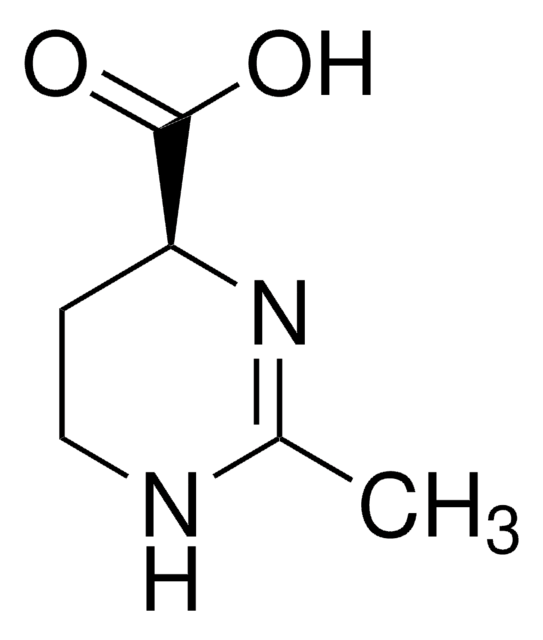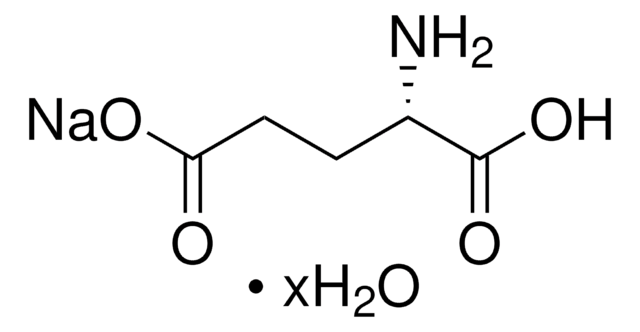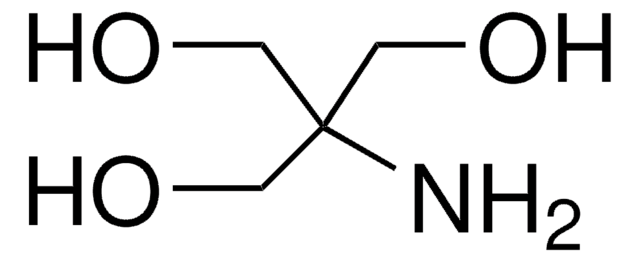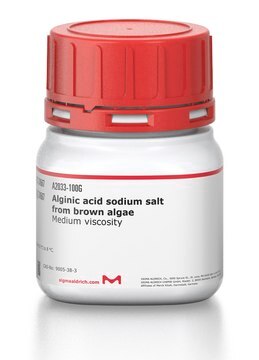70709
Hydroxyectoine
≥95% (HPLC)
Synonym(s):
(4S,5S)-5-Hydroxy-2-methyl-1,4,5,6-tetrahydropyrimidine-4-carboxylic acid, THP(A)
Sign Into View Organizational & Contract Pricing
All Photos(1)
About This Item
Empirical Formula (Hill Notation):
C6H10N2O3
CAS Number:
Molecular Weight:
158.16
MDL number:
UNSPSC Code:
24112111
PubChem Substance ID:
NACRES:
NA.21
Recommended Products
Quality Level
assay
≥95% (HPLC)
form
solid
SMILES string
CC1=N[C@@H]([C@@H](O)CN1)C(O)=O
InChI
1S/C6H10N2O3/c1-3-7-2-4(9)5(8-3)6(10)11/h4-5,9H,2H2,1H3,(H,7,8)(H,10,11)/t4-,5-/m0/s1
InChI key
KIIBBJKLKFTNQO-WHFBIAKZSA-N
Looking for similar products? Visit Product Comparison Guide
Other Notes
Stabilizer for enzymes and biological macromolecules
wgk_germany
WGK 1
flash_point_f
Not applicable
flash_point_c
Not applicable
ppe
dust mask type N95 (US), Eyeshields, Gloves
Choose from one of the most recent versions:
Already Own This Product?
Find documentation for the products that you have recently purchased in the Document Library.
Klaus Reuter et al.
PloS one, 5(5), e10647-e10647 (2010-05-26)
As a response to high osmolality, many microorganisms synthesize various types of compatible solutes. These organic osmolytes aid in offsetting the detrimental effects of low water activity on cell physiology. One of these compatible solutes is ectoine. A sub-group of
Annika C Mosier et al.
mBio, 4(2), e00484-e00412 (2013-03-14)
Microorganisms grow under a remarkable range of extreme conditions. Environmental transcriptomic and proteomic studies have highlighted metabolic pathways active in extremophilic communities. However, metabolites directly linked to their physiology are less well defined because metabolomics methods lag behind other omics
Wei-Chuan Chen et al.
Journal of bioscience and bioengineering, 128(3), 332-336 (2019-04-03)
Hydroxyectoine, an ectoine derivative, is the most common compatible solute in halophilic microorganisms for resisting harsh environments. Compatible solutes can be utilized in fields such as cosmetics, medicine, and biochemistry. Moderately halophilic microorganisms produce much less hydroxyectoine as compared with
S Cantera et al.
Bioresource technology, 267, 401-407 (2018-07-22)
This study constitutes the first-proof-of-concept of a methane biorefinery based on the multi-production of high profit margin substances (ectoine, hydroxyectoine, polyhydroxyalkanoates (PHAs) and exopolysaccharides (EPS)) using methane as the sole carbon and energy source. Two bubble column bioreactors were operated
Stanislav Obruca et al.
Applied microbiology and biotechnology, 100(3), 1365-1376 (2015-11-23)
Poly(3-hydroxybutyrate) (PHB) is a common carbon- and energy-storage compound simultaneously produced and degraded into its monomer 3-hydroxybutyrate (3HB) by numerous bacteria and Archae in a metabolic pathway called the PHB cycle. We investigated 3HB as a chemical chaperone capable of
Our team of scientists has experience in all areas of research including Life Science, Material Science, Chemical Synthesis, Chromatography, Analytical and many others.
Contact Technical Service




